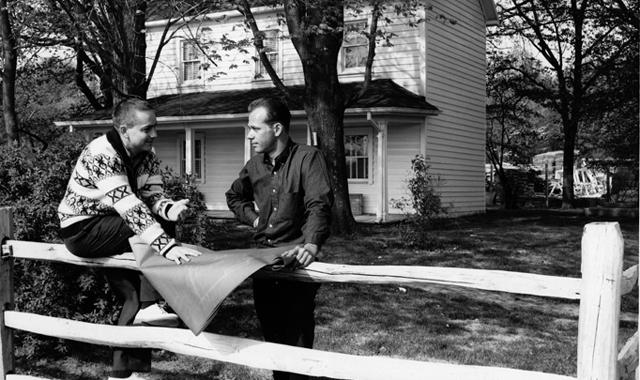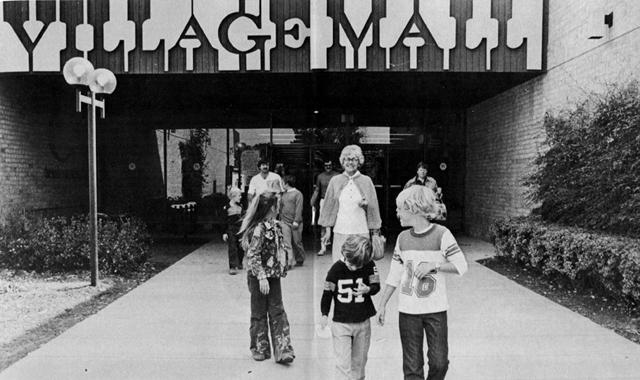Village History
It all began with architect and visionary Clarence Kettler. He asked his two brothers, Milton and Charles, to join him, and in 1952 they started Kettler Brothers, Incorporated. The Kettler brothers built Montgomery Village after Clarence had the idea of building a special town. He looked around Gaithersburg, where there were numerous farms. In 1962, they bought the Walker Farm in Gaithersburg, the first piece of land to become part of Montgomery Village. They also bought other farms (listed below). Look at a Montgomery Village map to see if you can find these names now being used in Montgomery Village. Don't forget to include the Walker Farm. Here's one hint: Walkers Choice apartments were named after Grover and Ralph Walker who owned the Walker Farm before they sold it to the Kettlers.
- Thomas Farm
- The Brothers Mills
- The French Farm
- The Patton Farm
- The Fulks Farm
- The Wilson Farm
- The James Walter Deppa property
The Walker Farm was the largest of all the properties that the Kettlers bought. It was 412 acres and now is Walker's Choice, Cider Mill, Horizon Run, Christopher Court, Dockside, Nathan's Hill, Millrace, the library, the day care center, Montgomery Village Plaza, Breckenridge, Grover's Forge, Lake Whetstone, South Valley Park and the former Lakeforest Mall site.
When did building start?
On Feb. 28, 1966, the Kettler brothers broke ground for the first house in Montgomery Village. They began moving fully grown trees into Montgomery Village so that it would look like the trees were here the entire time. Remember, the land was mostly farmland, which means there probably weren't very many trees. Instead of buying little trees, they had 10,000 full-grown pin-oak trees planted in what would become Whetstone and Stedwick. They purchased a machine to put the large trees into the ground; this was one of the first of its kind on the east coast.
Did you know?
The Montgomery Village symbol is not trees but is really two stick figures reaching toward the heavens in a gesture of friendship and peace.
How did the Montgomery Village Foundation start?
On Oct. 17, 1966, the Montgomery Village Foundation, Inc. (MVF) Articles of Incorporation were officially filed and recorded with a mission statement setting forth its purpose to promote the health, safety and welfare of the residents of the community of Montgomery Village. In 1970, MVF received its 501(c)(4) nonprofit designation from the U.S. Internal Revenue Service. The Articles of Incorporation set forth the activities in which MVF can be involved on behalf of all residents, essentially mirroring what is provided by a city government. Additional powers are granted to MVF through Declarations of Covenants that are included as part of the deed to all residential property within Montgomery Village and associated with either one of the 12 homes corporations, 11 condominium associations or four apartment rental complexes. This additional authority includes collection of assessments to meet the costs of preserving and maintaining the 335-plus acres of land and facilities owned by MVF, as well as a wide range of services offered through MVF's five departments.
Were the lakes always here?
Lake Whetstone was created by a dam, and the island in the middle was created by digging the bottom of the lake deeper when there was no water in it. Clarence Kettler was so particular about the lake that he even had it drained two times to make sure it was just right. Each time it was drained, the bulldozers and other equipment were called back in. Lake Whetstone is about 19 feet deep at its deepest point. Lake Whetstone opened for boating and fishing in September 1967.
Clarence Kettler knew Lake Whetstone was going to be beautiful. He wanted to make sure that people driving along Montgomery Village Avenue could see the lake. Because of this, the lanes that go from Montgomery Village toward Route 355 are higher than those going into Montgomery Village.
Who moved here first?
The first model homes were opened in Lakeside in August 1967. In September, more opened in the Clusters of Stedwick. The golf course also opened in September of that year, but no residents lived in the Village yet. The first residents of Montgomery Village moved in on September 25,1967 in Goshenside. They were the Bartik family. Also on the same day, the Crosby family moved into a home on Whetstone Drive. That was nearly 58 years ago. The water and sewer system was not quite ready, so the Crosby family had a water tank truck in their backyard for a week until the water was okay to drink.
What else was built in the beginning?
A Visitors Center was one of the main buidlings for some time in the Village. This building had housing brouchures and scale models of homes, as well as information about the amenities and the future plans for the entire community. The Kettler Brothers used this great marketing tool to welcome and showcase their vision to potential residents.
In 1968, the Whetstone Community Center opened, as well as Whetstone Elementary and Montgomery Village Junior High schools. High schoolers went to Gaithersburg High School (GHS) until Seneca Valley High School was opened in the mid-1970s. When Watkins Mill High School (WMHS) opened in September 1989, most Village high schoolers attended there. This holds true today, with the exception of residents of East Village and Eastgate, who still attend GHS.
In 1970, the Village Mall opened, which is now the Village Shopping Center on Montgomery Village Avenue. At one time, it was completely enclosed like a regular shopping mall. Then in 1971, the Holiday Inn opened. In 1973, bus service to Washington, D.C., began, which the Kettler Brothers arranged. The station where you boarded the bus served coffee and donuts in the mornings. The building that was once the station was moved and became the North Creek Nature Center, which is located at North Creek Lake.
What do the names mean?
Clarence Kettler felt that names were important and that future residents should be able to identify with their communities. Here is a list of names found in Montgomery Village and where they came from:
- Choice, like Walkers Choice, means to rent. Walkers Choice is a rental community with apartments, townhomes and garden apartments. Some were changed to condominiums.
- Stedwick means "the Meadow," or "the land that was a dairy farm."
- Frenchton Place is the Elkins farm, which was once owned by the French family.
- Seneca, as in Seneca Creek, comes from the Native American tribes of the great Seneca nation who once lived in this area. Early owners of homes in the Village found arrowheads in the earth.
- Center Court, the condominiums, happens to be located in the center of the Village. It has a central court between its buildings.
- Lost Knife Road comes from Walker farm, but a fictional legend was created about a Confederate Army Private named Charles Digging who fought in the Civil War. One rainy night, he was caught behind the enemy lines of the Union troops. The Union Army captured him, and they gave him a coat and horse, which he realized belonged to a Union General. Knowing this, he finished out the rest of the war pretending and everyone believing that he was a general. Although the story isn't true, there used to be a group of people in the Village devoted to preserving the legend of General Charles Digging.
- Patton Ridge is named for the farm that was owned by Julian T. Patton and his family.
- Sparr Spring, one of the roads in the Clusters, was actually a mistake and should have been called Parrs Spring, which was the boundary point between Montgomery, Carroll and Howard counties.
- Watkins Mill is named for one of the grist mills where corn was ground up. The Watkins family once owned and operated one of the mills.
- McKendree is named for Mr. McKendree (Mac) G. Fulks, a member of one of the oldest families in Gaithersburg.
- Goshenside comes from the biblical name and an old land grant called The Land of Goshen.
- Partridge Place comes from the number of partridge birds that are heard in the area on summer evenings.
The Village today
Today, Montgomery Village has more than 40,000 residents and is nearly 60 years old. Montgomery Village Foundation, Inc. has nurtured and sustained the growth of the Village as well as expanded its ownership of public land, which now totals more than 335 acres, for the benefit of all residents.
MVF owns and operates six pools, more than 20 sports courts (tennis, pickleball, basketball, soccer), four community centers, 19 recreation and park areas, a multigolf course and a natural amphitheater. Year round, the Department of Recreation and Parks offers a variety of programs for all ages, and during the summer sponsors a community-wide Independence Day Parade and Celebration and concerts at the amphitheater.
The Village News is published in print once per quarter and distributed to each residence in Montogmery Village. Content is updated regularly online so that residents and non-residents alike can stay informed about the latest happenings in Montgomery Village.



